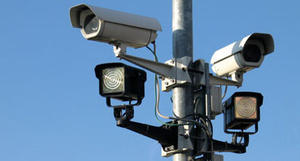Who is to blame for delays in installing surveillance cameras in NYC?
The project of installing surveillance cameras in New York subways was meant to be completed by Lockheed martin by August 2008; now, nearly two years later, the best-case scenario is completion (by a company or companies other than Lockheed) of a scaled-back electronic security system by some time in 2012; Lockheed Martin, NYC blame — and sue — each other for contract violations

Mounted urban surveillance cameras // Source: scrapetv.com
Following two fatal stabbings in the New York City subways and then the failed bombing attempt by Faisal Shahzad in Times Square, media scrutiny of the city’s surveillance system became more intense. In particular, MSNBC, WNYC, and other outlets led with stories about how “half of NYC security cams don’t work” or “none of the roughly 2,000 cameras [in the subways] … are fully hooked up to surveillance rooms where employees can monitor them.”
Security System News’s L. Samuel Pfeifle writes that the implicit understanding many of the stories convey is that Lockheed has installed cameras that do not work, or, worse, were installed in such a fashion that they are not even connected to anything.
Pfeifle writes that this is not the real story. Much of it can be discerned by reading through legal filings from the summer of 2009 in connection with Lockheed’s suit against NYC’s Metropolitan Transit Authority (MTA), in which the company alleges, alternately, that the MTA breached its contract with the company or wrongfully terminated it (which of those things actually happened is up to a judge to decide). Should the judge rule in its favor, Lockheed stands to get either $80 million or $138 million from the MTA.
The MTA counter-sued, alleging breach of contract on Lockheed’s part. Should Lockheed lose, it would have to pay out something in the realm of $92 million.
Pfeifle notes that it is possible a settlement winds up somewhere in between all of those figures.
What everyone agrees upon is that the project was meant to be completed by August 2008 and that now, nearly two years later, the best-case scenario is completion (by a company or companies other than Lockheed) of a scaled-back electronic security system by some time in 2012.
In January, the New York State Controller’s office released its “Progress Report: The MTA Capital Security Program,” detailing where the project stands. Among its findings: “The insurance companies holding the performance bonds for the Lockheed contract have been ‘unable to conclude that Lockheed is, in fact, in material breach’ of its contract.” It also found the project to already be more than $200 million over budget.
Pfeifle says that while much of the legal wrangling involves “additional work orders” and what is and what is not in the scope of the contract, there appear to be three major issues that held up the project:
- a lack of a working IP network
- lack of access to, or dangerous conditions at, specific work areas
- interference by agencies that were not party to the contract
Specifically, says Lockheed in the filings, “None of the communication rooms have the necessary network access, the absence of which makes it impossible for Lockheed Martin to install a Security System that will actually transmit information.” Those cameras that are not connected? Essentially, Lockheed was not contracted to build an IP network and one has not been provided to them by the MTA.
Further, “In particular, Defendants MTA Capital and MTA demanded that Lockheed Martin obtain approval for the plans and specifications from non-parties to the Contract — even though the Contract does not require any such approval from non-parties. Those non-parties included at least five other agencies, including New York City Transit Authority (“NYCT”), Long Island Railroad (“LIRR”), Metro North Railroad (“MNR”), Bridges & Tunnels (“B&T”), and MTA Police Department (“MTAPD”) (collectively “MTA Agencies”).”
Pfeifle writes that “as each phase of the project moved along, Lockheed was being asked to get approval from agencies that were not its master, and those agencies repeatedly requested changes to the designs.”
It remains unclear when, and if, fault will be found in the whole NYC subway camera mess. The lawsuits between Lockheed and the MTA have been in the discovery phase for nearly a year now, and no one would speculate on a time frame for the case’s conclusion. Lockheed chose not to comment for Pfeifle’s story, while pointing to its arguments in its court filings. For a statement, the company released the following to Security Systems News:
We initiated legal action as a last resort. This is an action rarely taken by Lockheed Martin, and it is only being taken after having exhausted all efforts to resolve the issues with the MTA. As the parties proceed with the discovery phase of litigation, we continue to believe that the termination of Lockheed Martin was wrongful and that MTA’s claims are without merit.
